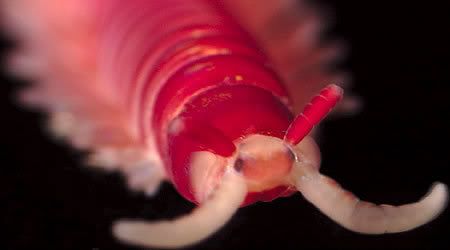Introduction to Annelids

Candy-striped Worm
Annelids are an important group of animals present in many habitats. They live just about everywhere on earth. Most can be found in wet environments, including marine and freshwater, while some live in moist soil underground. There are still many species within this phylum that we are unfamiliar with and many yet to be discovered. Segmented worms are usually small animals; tiny aquatic worms are less than half a millimetre long while they are some species that can grow up to as mush as 3 meters (the seep tube worm Lamellibrachia luymesi). Although most annelids are characteristically worm-like in appearance, they can range greatly in their colour, patterning, and other features.
There are three main classes with the Phylum Annelida:
Class Polychaeta: (poly=many, chaeta=bristles)
The largest group of annelids and the majority of which are marine. They are divided into equal segments, with paired paddlelike appendages (parapodia) tipped with bristles on each that they can use for swimming, burrowing, and creating feeding currents. Most Polychaetes live in coral reefs, sand, mud, pile of rocks, open water and even in self built tubes. They can range from being dull and unassuming to brightly coloured and luminescent.
Examples: (Sea Mouse)
 (Sea Mouse Ventral View)
(Sea Mouse Ventral View)Class Oligochaeta (Oligo=few, Chaeta=bristles)
As the name implies, this class of annelids have fewer bristles than polychaetes. They usually have a few setae on each segment and more common on land and freshwater. They lack the parapodia of polychaetes and have clitellum for reproduction. Most are detritus feeders but there are some predatory species. The most well know examples of oligochaetes are the earthworms we see all the time
(i.e. earthworms)

Class Hirudinea
Members of this class are what we know as leeches. Mostly living in moist tropical, these include the bloodsucking variety we hear of all the time and some other predatory sepcies. Generally they are no more than 6 cm long but can some can grow up to about 30 cm. Most leehes live in freshwater and are external parasities that feeds on the blood on body fluids of its host. All leeches also have powerful suckers on both ends of their body, the posterior one used anchor itself and the anterior one that surrounds it's mouth attaches it to it's host. All leech species are carnivorous and are hermaphrodites like earthworms
(i.e. leeches)
As the name implies, this class of annelids have fewer bristles than polychaetes. They usually have a few setae on each segment and more common on land and freshwater. They lack the parapodia of polychaetes and have clitellum for reproduction. Most are detritus feeders but there are some predatory species. The most well know examples of oligochaetes are the earthworms we see all the time
(i.e. earthworms)

Class Hirudinea
Members of this class are what we know as leeches. Mostly living in moist tropical, these include the bloodsucking variety we hear of all the time and some other predatory sepcies. Generally they are no more than 6 cm long but can some can grow up to about 30 cm. Most leehes live in freshwater and are external parasities that feeds on the blood on body fluids of its host. All leeches also have powerful suckers on both ends of their body, the posterior one used anchor itself and the anterior one that surrounds it's mouth attaches it to it's host. All leech species are carnivorous and are hermaphrodites like earthworms
(i.e. leeches)





